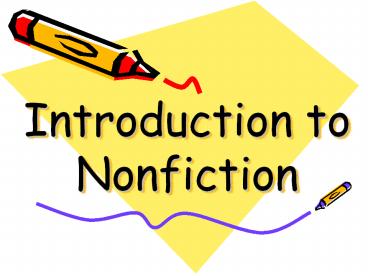Introduction to Nonfiction - PowerPoint PPT Presentation
Title:
Introduction to Nonfiction
Description:
Introduction to Nonfiction ... Infer Meaning Infer meaning of unfamiliar words Infer with text clues Tackle the meaning of language Crack open text features Read ... – PowerPoint PPT presentation
Number of Views:459
Avg rating:3.0/5.0
Title: Introduction to Nonfiction
1
Introduction to Nonfiction
2
- This PowerPoint was created by Linda Sears and
Heather Kirk. - Some strategies came from Comprehension Toolkit.
- Thank you to OMIS wonderful reading coach, Mrs.
Dudley, for her input.
3
What are nonfiction materials?
- Nonfiction contains facts
- and information.
4
What kinds of things are in nonfiction books?
- -actual persons, places, and events
- -facts
5
How should I read nonfiction books?
6
IDEAS
- Investigate the text
- Decide on a plan of action
- Evaluate your effort
- Adjust your reading
- Summarize
- This ideas acronym came from Mailbox Magazine.
7
Step 1Investigate the text
8
- Read the title, main headings, and subheadings.
- Explore the pictures, charts, maps, and graphs.
- Think about what you already know.
9
Step 2Decide on a plan of action
10
- Look over the pages that you will read.
- Figure out what you need to learn.
- Decide how you will remember what you read.
- Read.
11
Step 3Evaluate your effort
12
1. Think about what you have read so far.2.
Does it make sense?3. Find the main ideas.4.
Keep reading!
13
Step 4Adjust your reading
14
1. Change your pace if you are behind or
ahead.2. Use context clues or look up unknown
words.3. Reread to make sure you understand.
15
Step 5 Summarize
16
1. Make the information stick!2. Review what
you learned.3. Summarize what you read.
17
What should I do while I read a nonfiction book?
18
Monitor Comprehension
- Follow your inner conversationquestions,
connections, confusions new information - Leave tracks of your thinking on Post-Its
or index cards - Review your thoughts and label what you are
thinking and doing as you read - Talk it over with someoneSHARE
- What new questions do you have?
19
Activate Connect
- Follow the text signposts
- Merge your thinking with new learning
- Connect the new to the known
20
Ask questions
- Question the text
- Read to discover answers
- Ask questions to expand thinking
21
Infer Meaning
- Infer meaning of unfamiliar words
- Infer with text clues
- Tackle the meaning of language
- Crack open text features
- Read with a question in mind
- Wrap your mind around the big ideas
22
Determine Importance
- Spotlight new thinking
- Record important ideas
- Target key information
- Determine WHAT to remember
- Distinguish between YOUR thinking and the
authors - Construct main ideas from supporting details
23
Nonfiction
- Read, think and react
- Think beyond the text
- Read to get the gist
- Reread and rethink
- Read, write and reflect.
24
Write downTitle Author Call NumberAR Test
Score
25
Third 9 Weeks
- Pass at least THREE nonfiction AR tests on books
in your January ZPD. - You may take as many tests as necessary to have 3
grades at 100 by March 6.






























![get⚡[PDF]❤ Archaeologists Dig for Clues (Let's-Read-and-Find-Out Science 2) PowerPoint PPT Presentation](https://s3.amazonaws.com/images.powershow.com/10049521.th0.jpg?_=20240607027)
